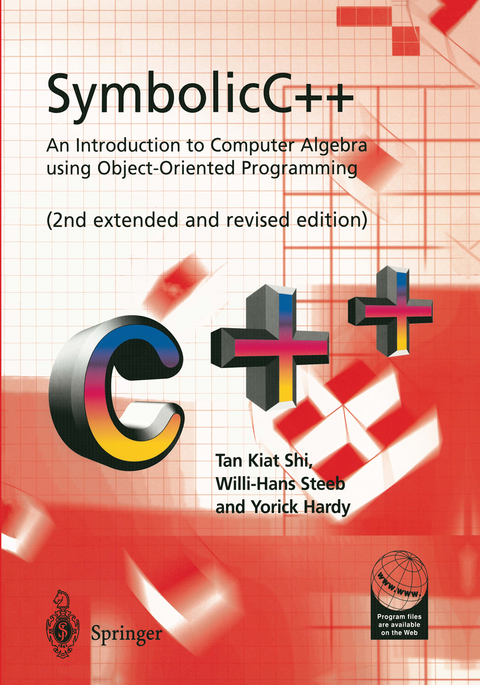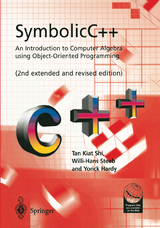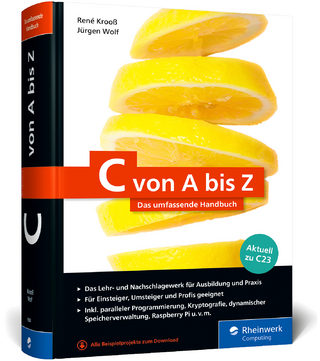SymbolicC++:An Introduction to Computer Algebra using Object-Oriented Programming
Springer London Ltd (Verlag)
978-1-85233-260-0 (ISBN)
Symbolic C++: An Introduction to Computer Algebra Using Object-Oriented
Programming provides a concise introduction to C++ and object-oriented
programming, using a step-by-step construction of a new object-oriented
designed computer algebra system - Symbolic C++. It shows how
object-oriented programming can be used to implement a symbolic algebra
system and how this can then be applied to different areas in mathematics
and physics.
This second revised edition:-
*Explains the new powerful classes that have been added to Symbolic
C++.
*Includes the Standard Template Library.
*Extends the Java section.
*Contains useful classes in scientific computation.
*Contains extended coverage of Maple, Mathematica, Reduce and MuPAD.
1 Introduction.- 1.1 What is Computer Algebra ?.- 1.2 Properties of Computer Algebra Systems.- 1.3 Pitfalls in Computer Algebra Systems.- 1.4 Design of a Computer Algebra System.- 2 Mathematics for Computer Algebra.- 2.1 Rings and Fields.- 2.2 Integers.- 2.3 Rational Numbers.- 2.4 Real Numbers.- 2.5 Complex Numbers.- 2.6 Vectors and Matrices.- 2.7 Quaternions.- 2.8 Polynomials.- 2.9 Differentiation.- 2.10 Integration.- 2.11 Commutativity and Noncommutativity.- 2.12 Tensor and Kronecker Product.- 2.13 Exterior Product.- 3 Computer Algebra Systems.- 3.1 Introduction.- 3.2 Reduce.- 3.3 Maple.- 3.4 Axiom.- 3.5 Mathematica.- 3.6 MuPAD.- 4 Object-Oriented Programming.- 4.1 Objects, Classes and Abstract Data Types.- 4.2 Message Passing.- 4.3 Inheritance.- 4.4 Polymorphism.- 4.5 Object-Oriented Languages.- 4.6 Summary.- 5 Basic Tools in C++.- 5.1 Pointers and References.- 5.2 Classes.- 5.3 Constructors and Destructor.- 5.4 Copy Constructor and Assignment Operator.- 5.5 Type Conversion.- 5.6 Operator Overloading.- 5.7 Class Templates.- 5.8 Function Templates.- 5.9 Friendship.- 5.10 Inheritance.- 5.11 Virtual Functions.- 5.12 Wrapper Class.- 5.13 Standard Template Library.- 5.14 Recursion.- 5.15 Summary.- 6 Classes for Computer Algebra.- 6.1 The Verylong Integer Class.- 6.2 The Rational Number Class.- 6.3 The Complex Number Class.- 6.4 The Quaternion Class.- 6.5 The Derive Class.- 6.6 The Vector Class.- 6.7 The Matrix Class.- 6.8 Array Classes.- 6.9 The String Class.- 6.10 Bit Vectors.- 6.11 The Linked List Class.- 6.12 The Polynomial Class.- 6.13 The Set Class.- 6.14 Summary.- 7 The Symbolic Class.- 7.1 Object-Oriented Design.- 7.2 Data Fields and Types of Symbol.- 7.3 Constructors.- 7.4 Operators.- 7.5 Functions.- 7.6 Simplification.- 7.7 Commutativity.- 7.8 Symbolic and Numeric Interface.- 7.9 Summary.- 8 Applications.- 8.1 Bit Vector Class.- 8.2 Verylong Class.- 8.3 Verylong and Rational Classes.- 8.4 Verylong, Rational and Derive Classes.- 8.5 Verylong, Rational and Complex Classes.- 8.6 Symbolic Class.- 8.7 Symbolic Class and Symbolic Differentiation.- 8.8 Matrix Class.- 8.9 Array and Symbolic Classes.- 8.10 Polynomial and Symbolic Classes.- 8.11 Lie Series Techniques.- 8.12 Spectra of Small Spin Clusters.- 8.13 Nonlinear Maps and Chaotic Behaviour.- 8.14 Numerical-Symbolic Application.- 8.15 Summary.- 9 Lisp and Computer Algebra.- 9.1 Introduction.- 9.2 Basic Functions of Lisp.- 9.3 Examples from Symbolic Computation.- 9.4 Lisp System based on C++.- 10 Program Listing.- 10.1 Verylong Class.- 10.2 Rational Class.- 10.3 Complex Class.- 10.4 Quaternion Class.- 10.5 Derive Class.- 10.6 Vector Class.- 10.7 Matrix Class.- 10.8 Array Class.- 10.9 String Class.- 10.10Bit Vector Class.- 10.11Linked List Class.- 10.12Polynomial Class.- 10.13Set Class.- 10.14Symbolic Class.- 11 PVM and Abstract Data Types.- 12 Error Handling Techniques.- 12.1 Error State.- 12.2 Exception Handling.- 13 Gnuplot and PostScript.
| Erscheint lt. Verlag | 2.2.2000 |
|---|---|
| Zusatzinfo | XVI, 692 p. |
| Verlagsort | England |
| Sprache | englisch |
| Maße | 155 x 235 mm |
| Themenwelt | Informatik ► Programmiersprachen / -werkzeuge ► C / C++ |
| Informatik ► Software Entwicklung ► Objektorientierung | |
| Mathematik / Informatik ► Mathematik | |
| ISBN-10 | 1-85233-260-3 / 1852332603 |
| ISBN-13 | 978-1-85233-260-0 / 9781852332600 |
| Zustand | Neuware |
| Informationen gemäß Produktsicherheitsverordnung (GPSR) | |
| Haben Sie eine Frage zum Produkt? |
aus dem Bereich




